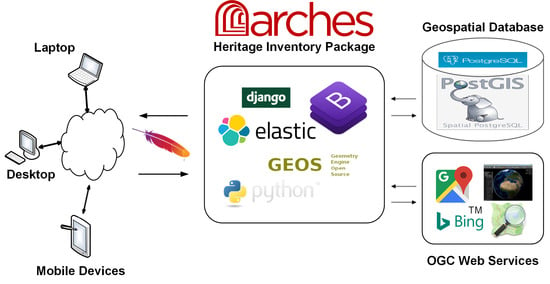Application of Open-Source Software in Community Heritage Resources Management
Abstract
:1. Introduction
2. Materials and Methods
2.1. Arches and Arches-HIP
- Heritage Resources: objects that are culturally significant, for example, temple, shrines, artifact, tombstones, buildings, and monuments.
- Heritage Resource Groups: gathering of individual heritage resources that are best regarded as a group such as region, landscapes, historic zones, and graveyards.
- Activity: resources that occur over a period of time, which include religious celebrations, investigations, excavations, and restoration.
- Historic Event: culturally significant occurrences including battles, protests, natural disasters such as volcanic eruptions, earthquakes, and flooding.
- Actor: resources that are persons, groups of people, or organizations, e.g., architects, research teams, surveying firms, and association.
- Information Objects: objects that encode information such as a photo, documents, audio and video recordings, signs, drawings, and inscriptions.
2.2. Other Related Open-Source Tools
- A Django-based web server tier, which is developed using Python programming language.
- A Bootstrap-based user interface using JavaScript and CSS (Cascading Style Sheets).
- A PostgreSQL relational database, and PostGIS, which is the spatial database extender for PostgreSQL.
- An Elasticsearch search engine, which can provide high performance full-text querying.
2.3. Heritage Resource Data
3. Results
3.1. Heritage Resources Database
3.2. Arches Web Applications
- Maintaining resource data: to update descriptions, location, classifications, components, measurements, condition assessment, images and files, related resources, and external system references of the resource.
- Evaluating Resource: to update the designation and evaluation criteria for the resource.
- Managing Resource: to review the edit history of the resource or delete the resource.
4. Discussion
5. Conclusions
Funding
Acknowledgments
Conflicts of Interest
References
- Rössler, M. Partners in site management. A shift in focus: Heritage and community involvement. In Community Development through World Heritage; Albert, M.T., Richon, M., Vnals, M.J., Witcomb, A., Eds.; UNESCO: Paris, France, 2012; pp. 27–31. ISBN 978-92-3-001024-9. [Google Scholar]
- Chirikure, S.; Pwiti, G. Community involvement in archaeology and cultural heritage management: An assessment from case studies in Southern Africa and elsewhere. Curr. Anthropol. 2008, 49, 467–485. [Google Scholar] [CrossRef]
- Mawere, M.; Sagiya, M.E.; Mubaya, T.R. Conservation conversations and community participation in the management of heritage sites in Zimbabwe. Greener J. Environ. Manag. Public Saf. 2012, 2, 7–16. [Google Scholar]
- Bushozi, P.M. Towards sustainable cultural heritage management in Tanzania: A case study of Kalenga and Mlambalasi sites in Iringa, Southern Tanzania. S. Afr. Archaeol. Bull. 2014, 69, 136–141. [Google Scholar]
- Mudge, M.; Ashley, M.; Schroer, C. A Digital Future for Cultural Heritage. Int. Arch. Photogram. Remote Sens. Spat Inf. Sci. 2007, 36–5/C53. Available online: http://www.isprs.org/proceedings/XXXVI/5-C53/papers/FP104.pdf (accessed on 29 October 2018).
- Santana Quintero, M.; Georgopoulos, A.; Stylianidis, E.; Lerma, J.L.; Remondino, F. CIPA’s Mission: Digitally Documenting Cultural Heritage. APT Bull. J. Preserv. Technol. 2017, 48, 51–54. [Google Scholar]
- Crofts, N.; Doerr, M.; Gill, T.; Stead, S.; Stiff, M. Definition of the CIDOC Conceptual Reference Model; ICOM/CIDOC CRM Special Interest Group; ICOM Deutschland: Berlin, Germany, 2011. [Google Scholar]
- Steiniger, S.; Bocher, E. An overview on current free and open source desktop GIS developments. Int. J. Geogr. Inf. Sci. 2009, 23, 1345–1370. [Google Scholar] [CrossRef]
- Steiniger, S.; Hunter, A.J. Free and open source GIS software for building a spatial data infrastructure. In Geospatial Free and Open Source Software in the 21st Century. Lecture Notes in Geoinformation and Cartography; Bocher, E., Neteler, M., Eds.; Springer: Berlin/Heidelberg, Germany, 2012; pp. 247–261. ISBN 978-3-642-10594-4. [Google Scholar]
- Brovelli, M.A.; Minghini, M.; Moreno-Sanchez, R.; Oliveira, R. Free and open source software for geospatial applications (FOSS4G) to support Future Earth. Int. J. Digit. Earth 2016, 10, 386–404. [Google Scholar] [CrossRef]
- Gkoumas, G.; Lazarinis, F. Preserving Cultural Heritage Using Open Source Collection Management Tools. Dig. Present. Preserv. Cult. Sci. Herit. 2013, 3, 169–175. [Google Scholar]
- Open Video Digital Library Toolkit. Available online: https://github.com/ovdlt/open-video-digital-library-toolkit (accessed on 10 September 2018).
- Marchionini, G.; Geisler, G. The Open Video Digital Library. D-Lib Mag. 2002, 8, 12. [Google Scholar] [CrossRef]
- CollectionSpace. Available online: http://www.collectionspace.org (accessed on 10 September 2018).
- The Open Video Project: A Shared Digital Video Collection. Available online: https://open-video.org/index.php (accessed on 10 September 2018).
- Meyer, E.; Grussenmeyer, P.; Perrin, J.P.; Durand, A.; Drap, P. A web information system for the management and the dissemination of Cultural Heritage data. J. Cult. Herit. 2007, 8, 396–411. [Google Scholar] [CrossRef] [Green Version]
- Vacca, G.; Fiorino, D.R.; Pili, D. A WebGIS for the knowledge and conservation of the historical buildings in Sardinia (Italy). Int. Arch. Photogram. Remote Sens. Spat. Inf. Sci. 2017. [Google Scholar] [CrossRef]
- Vacca, G.; Fiorino, D.R.; Pili, D. A spatial information system (SIS) for the architectural and cultural heritage of Sardinia (Italy). ISPRS Int. J. Ceo-Inf. 2018, 7, 49. [Google Scholar] [CrossRef]
- Petrescu, F. The Use of GIS Technology in Cultural Heritage. Int. Arch. Photogram. Remote Sens. Spat. Inf. Sci. 2007, XXXVI–5/C53. Available online: http://www.isprs.org/proceedings/XXXVI/5-C53/papers/FP114.pdf (accessed on 29 October 2018).
- Smuts, K.; Mlungwana, N.; Wiltshire, N. SAHRIS: South Africa’s integrated, web-based heritage management system. J. Cult. Herit. Manag. Sustain. Dev. 2016, 6, 38–152. [Google Scholar] [CrossRef]
- South African Heritage Resources Agency. South African Heritage Resources Information System (SAHRIS). Available online: https://www.sahra.org.za/sahris/about/sahris (accessed on 10 September 2018).
- Paul Getty Trust and World Monuments Fund. Arches: Fact Sheet, Standards & Interoperability, Project Background, Implementations of Arches, and Downloads. Available online: http://www.archesproject.org (accessed on 10 September 2018).
- Carlisle, P.K.; Avramides, I.; Dalgity, A.; Myers, D. The Arches Heritage Inventory and Management System: A Standards-Based Approach to the Management of Cultural Heritage Information. In Proceedings of the CIDOC (International Committee for Documentation of the International Council of Museums) Conference Access and Understanding—Networking in the Digital Era, Dresden, Germany, 6–11 September 2014. [Google Scholar]
- Myers, D.; Dalgity, A.; Avramides, I.; Wuthrich, D. Arches: An open source GIS for the inventory and management of immovable cultural heritage. In Progress in Cultural Heritage Preservation. EuroMed 2012. Lecture Notes in Computer Science; Ioannides, M., Fritsch, D., Leissner, J., Davies, R., Remondino, F., Caffo, R., Eds.; Springer: Berlin/Heidelberg, Germany, 2012; Volume 7616, pp. 817–824. [Google Scholar]
- Wiltshire, N.G. The use of SAHRIS as a state sponsored digital heritage repository and management system in South Africa. Int. Ann. Photogram. Remote Sens. Spat. Inf. Sci. 2013, II–5/W1, 325–330. [Google Scholar] [CrossRef]
- Mlungwana, N. Using SAHRIS a web-based application for creating heritage cases and permit applications. Int. Arch. Photogram. Remote Sens. Spat. Inf. Sci. 2015, XL–5/W7, 337–341. [Google Scholar] [CrossRef]
- Smuts, K. SAHRIS: Using the South African Heritage Register to report, track and monitor heritage crime. Int. Arch. Photogram. Remote Sens. Spat. Inf. Sci. 2015, XL–5/W7, 395–402. [Google Scholar] [CrossRef]
- Drupal. Documentation. Available online: https://www.drupal.org/docs/user_guide/en/understanding-drupal.html (accessed on 10 September 2018).
- Django. Overview of Django. Available online: https://www.djangoproject.com/start/overview/ (accessed on 10 September 2018).
- Barton, C.; Cox, A.; Cruz, S.D.; Hansen, J. Cultural-heritage inventory implementations: The versatility of the Arches system. APT Bull. J. Preserv. Technol. 2017, 48, 19–28. [Google Scholar]
- International Core Data Standard for Archaeological Sites and Monuments. In Documenting the Cultural Heritage; Thornes, R.; Bold, J. (Eds.) The Getty Information Institute: Los Angeles, CA, USA, 1998. [Google Scholar]
- The Getty Conservation Institute and World Monuments Fund. MEGA-Jordan: The National Heritage Documentation and Management System. Available online: http://megajordan.org/ (accessed on 10 September 2018).
- Myers, D.; Dalgity, A. The Middle Eastern Geodatabase for Antiquities (MEGA): An Open Source GIS-Based Heritage Site Inventory and Management System. Available online: http://www.getty.edu/conservation/our_projects/field_projects/jordan/mega_jordan_cot_article.pdf (accessed on 10 September 2018).
- Arches-HIP Documentation. Available online: https://arches-hip.readthedocs.io/ (accessed on 10 September 2018).
- Arches Documentation v3.1.2. Available online: https://arches.readthedocs.io/en/3.1.2/ (accessed on 10 September 2018).
- Arches Project: Customization of Arches for City of Los Angeles. Available online: http://www.getty.edu/conservation/our_projects/field_projects/arches/arches_city_la.html (accessed on 10 September 2018).
- Nouli Community Association. Available online: http://www.nlica.org.tw/ (accessed on 10 September 2018).
- Pygal. Available online: http://www.pygal.org/en/latest/ (accessed on 10 September 2018).
- GEOS—Geometry Engine, Open Sources. Available online: http://trac.osgeo.org/geos (accessed on 10 September 2018).
- Chen, L.K.; Inoue, H.; Won, C.W.; Lin, C.H.; Lin, K.F.; Tsay, S.F.; Lin, P.F.; Li, S.H. Challenges of urban aging in Taiwan: Summary of urban aging forum. J. Clin. Gerontol. Geriat. 2013, 4, 97–101. [Google Scholar] [CrossRef]
- Jan, J.F. Digital heritage inventory using open source geospatial software. In Proceedings of the 22nd International Conference on Virtual Systems & Multimedia (VSMM), Kuala Lumpur, Malaysia, 17–21 October 2016. [Google Scholar]
- Mao, W.H. Application of Open Source GIS in Digital Conservation of Heritage: A Case Study of Arches. Master’s Thesis, National Chengchi University, Taipei, Taiwan, 2016. [Google Scholar]
- Nouli Community Association (Built with Arches). Available online: http://arches.nccu.edu.tw/ (accessed on 10 September 2018).
- The LizardQ Stitcher. Available online: https://www.lizardq.com/en/features-software/ (accessed on 10 September 2018).
- LizardQ User Manual. Available online: https://www.lizardq.com/cdn/docs/LizardQUserManual.pdf (accessed on 10 September 2018).
- GNU Image Manipulation Program (GIMP). Available online: https://www.gimp.org/ (accessed on 10 September 2018).
- Spatial Media Metadata Injector. Available online: https://github.com/google/spatial-media/blob/master/spatialmedia/README.md (accessed on 10 September 2018).
- YouTube Help. Upload 360-Degree Videos. Available online: https://support.google.com/youtube/answer/6178631?hl=en (accessed on 10 September 2018).
- Keyhole Markup Language. KML Tutorial. Available online: https://developers.google.com/kml/documentation/kml_tut (accessed on 10 September 2018).
- EPSG (European Petroleum Survey Group):4326. Available online: http://spatialreference.org/ref/epsg/4326/ (accessed on 10 September 2018).
- Wikipedia. Well-Known Text. Available online: https://en.wikipedia.org/wiki/Well-known_text (accessed on 10 September 2018).
- Tang, C.P.; Tang, S.Y. Institutional Adaptation and Community-Based Conservation of Natural Resources: The Cases of the Tao and Atayal in Taiwan. Hum. Ecol. 2010, 38, 101–111. [Google Scholar] [CrossRef]
- Virtualenv. Available online: https://virtualenv.pypa.io/en/stable/ (accessed on 10 September 2018).
- Docker. Available online: https://www.docker.com/ (accessed on 10 September 2018).

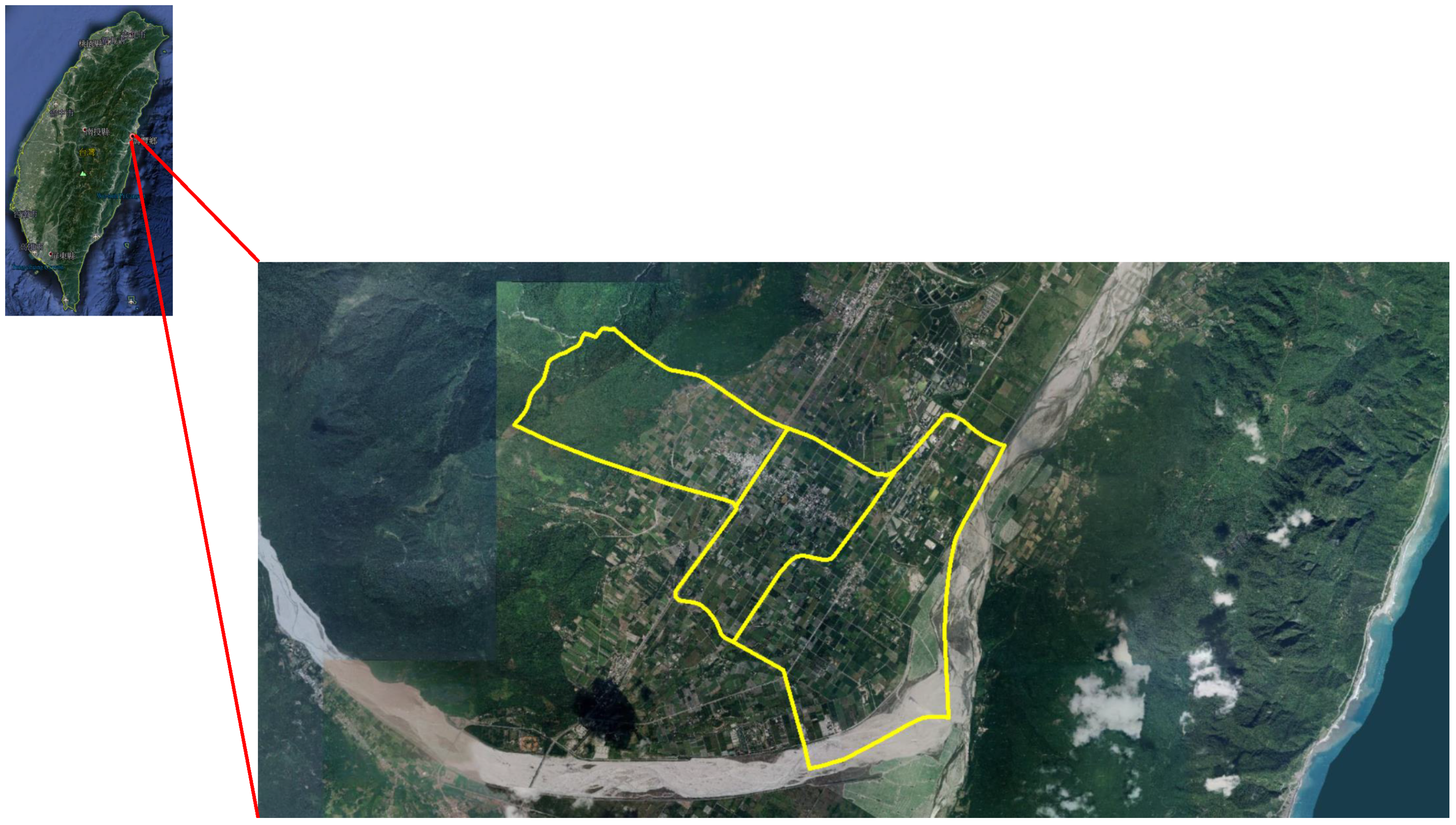

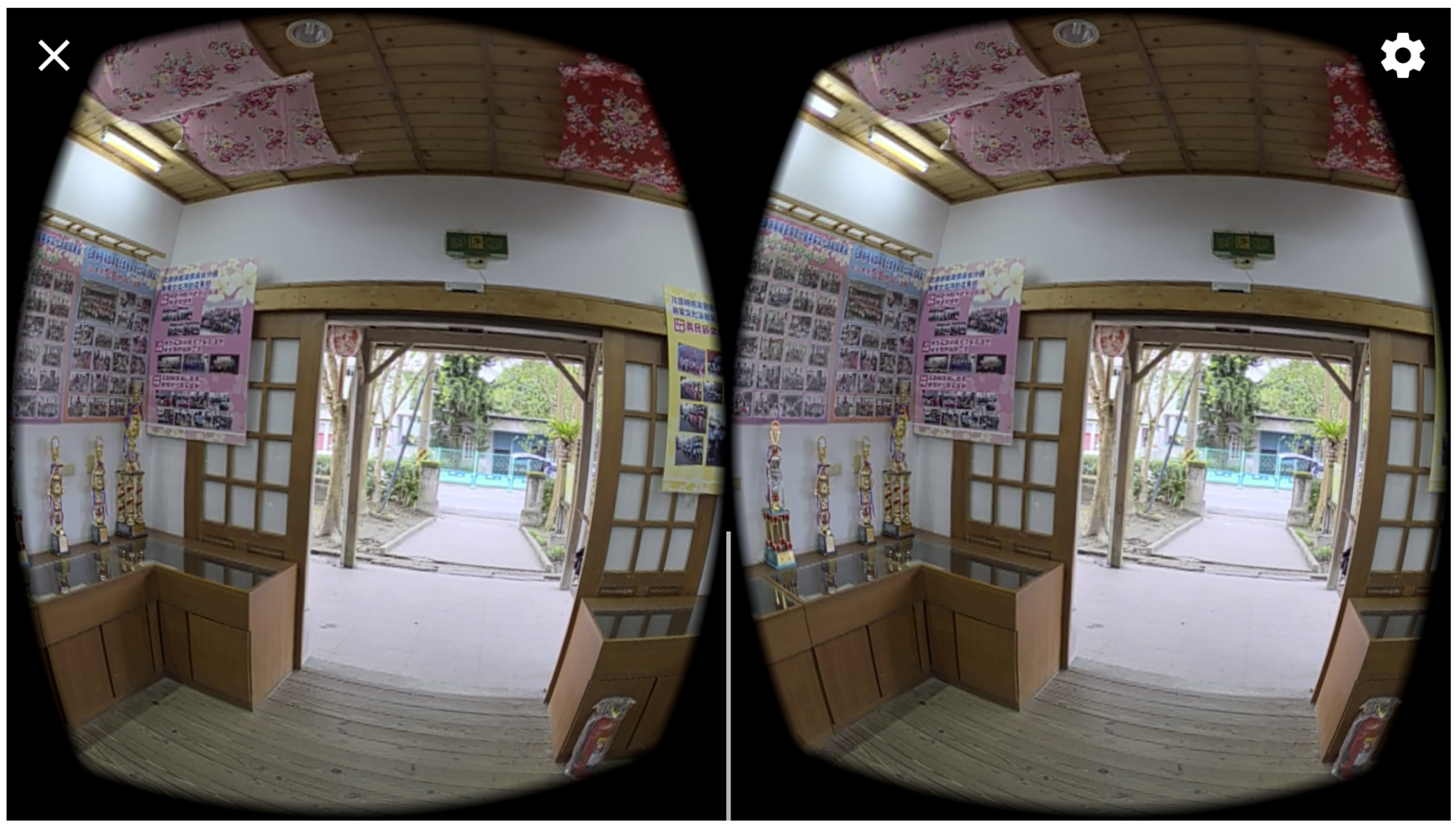

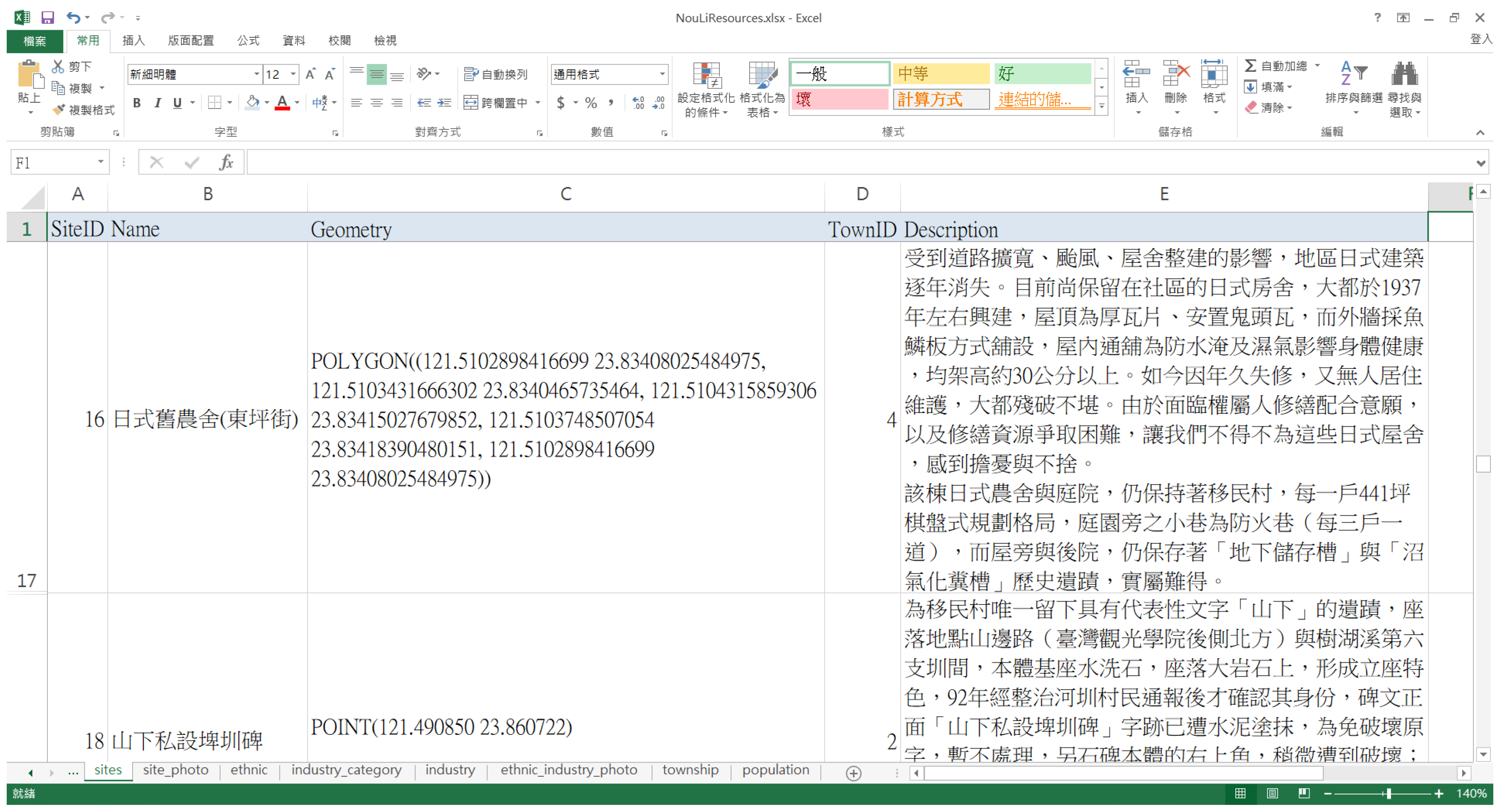


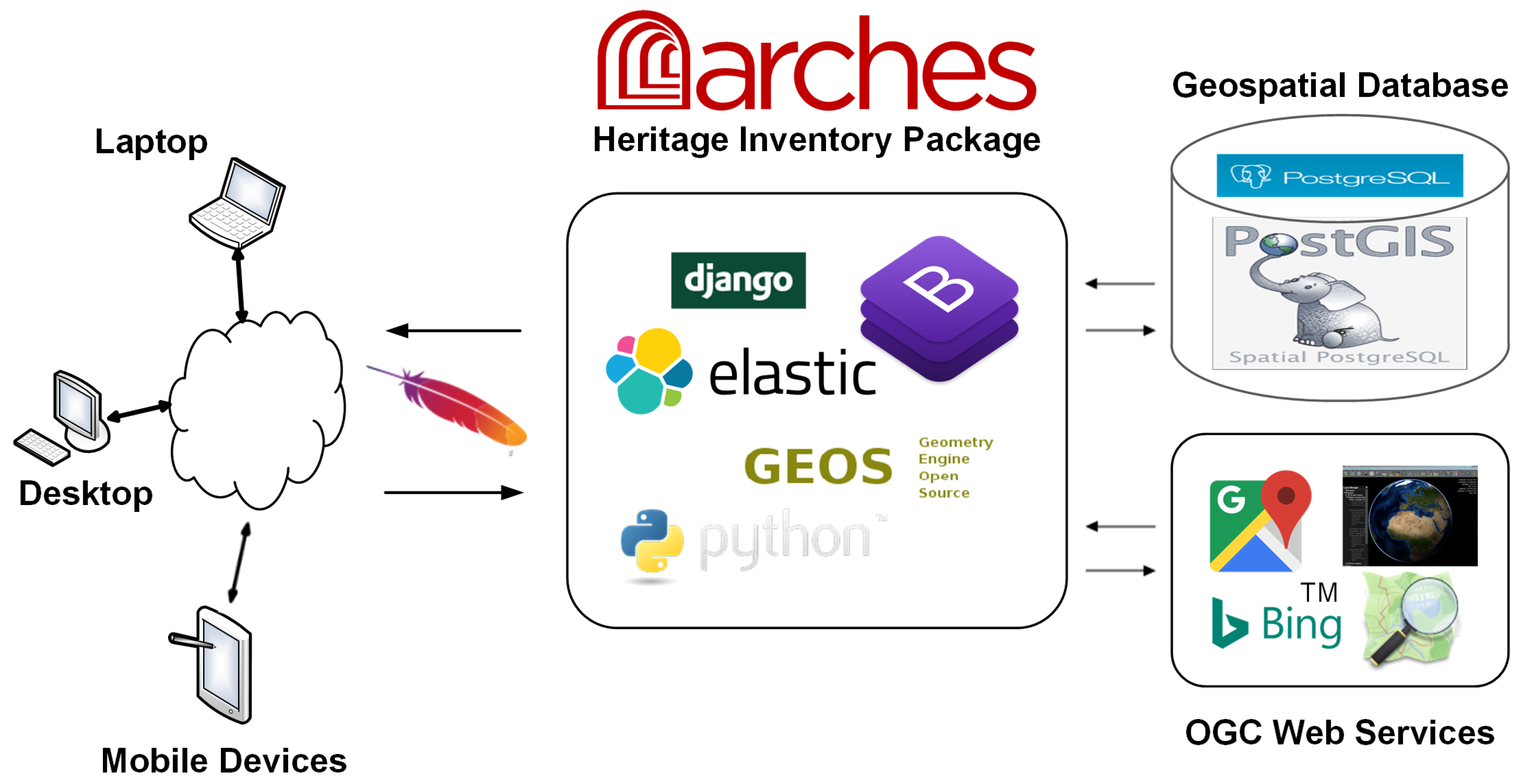
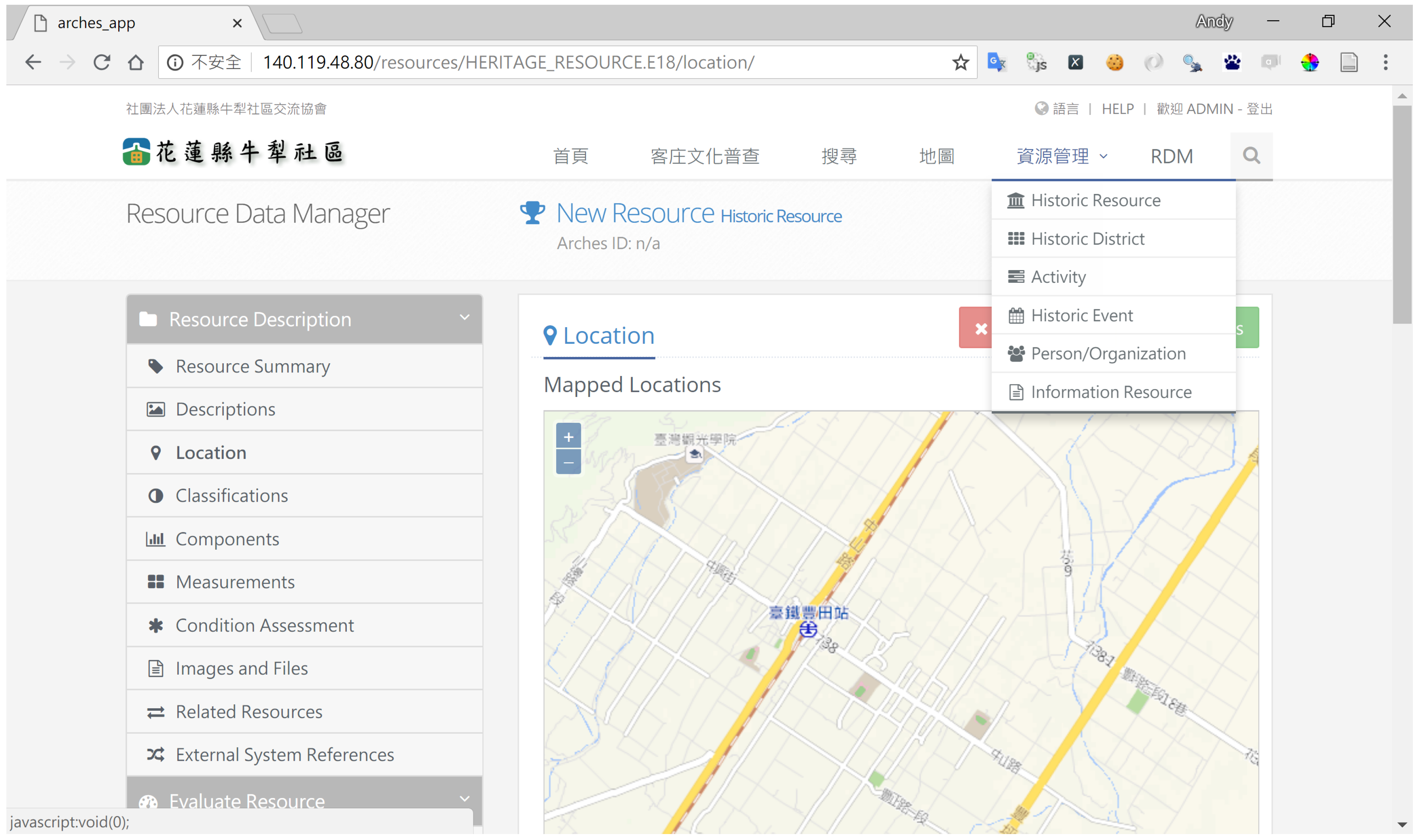


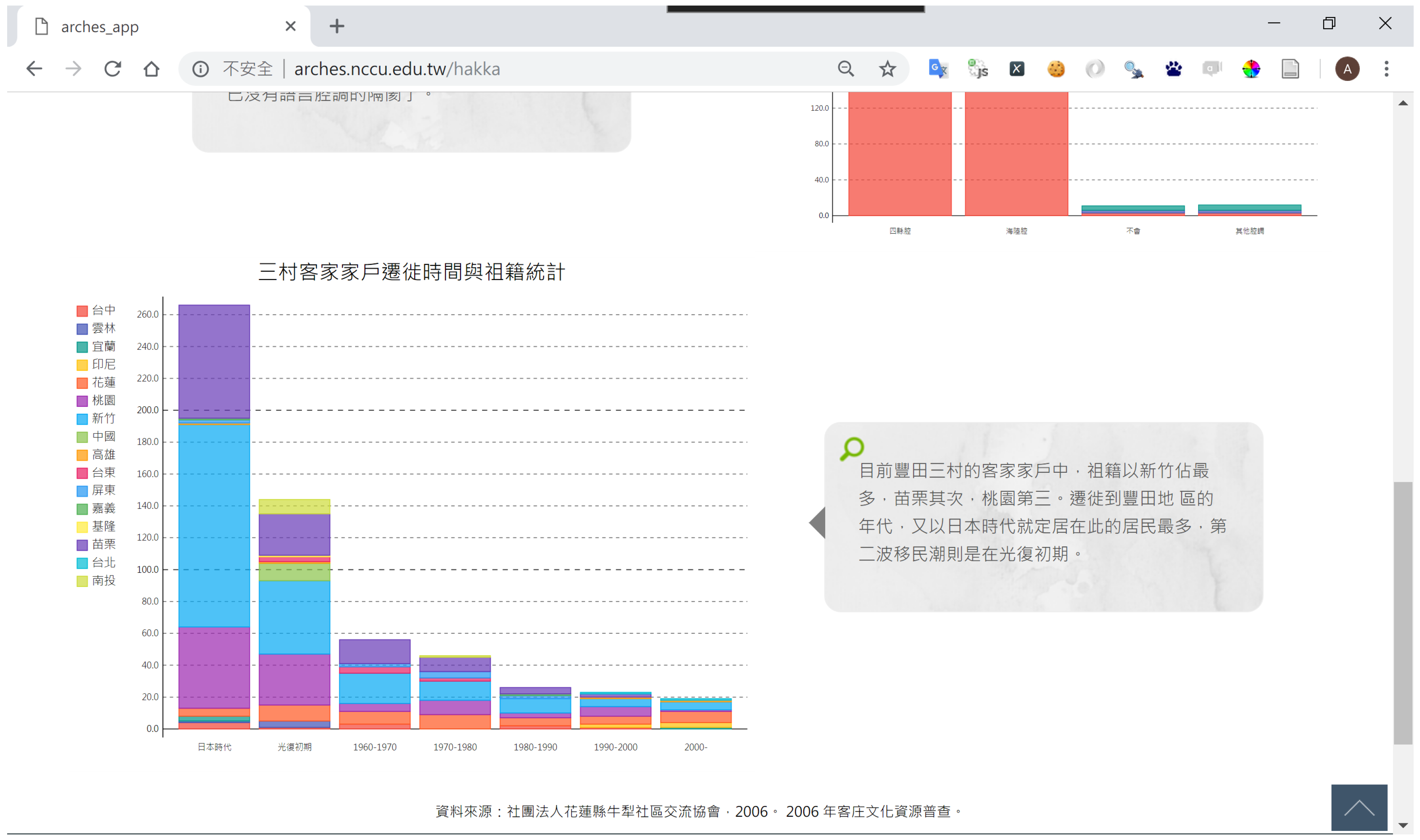
| Entity Type | Authority Document |
|---|---|
| CONDITION_TYPE.E55 | CONDITION_AUTHORITY_DOCUMENT.csv |
| CULTURAL_PERIOD.E55 | CULTURAL_PERIOD_AUTHORITY_DOCUMENT.csv |
| DISTURBANCE_TYPE.E55 | DISTURBANCE_TYPE_AUTHORITY_DOCUMENT.csv |
| LANGUAGE.E55 | LANGUAGE_AUTHORITY_DOCUMENT.csv |
| MATERIAL.E57 | MATERIAL_AUTHORITY_DOCUMENT.csv |
| MEASUREMENT_TYPE.E55 | MEASUREMENT_TYPE_AUTHORITY_DOCUMENT.csv |
| MODIFICATION_TYPE.E55 | MODIFICATION_TYPE_AUTHORITY_DOCUMENT.csv |
| NAME_TYPE.E55 | NAME_TYPE_AUTHORITY_DOCUMENT.csv |
| SETTING_TYPE.E55 | SETTING_TYPE_AUTHORITY_DOCUMENT.csv |
| STYLE.E55 | STYLE_AUTHORITY_DOCUMENT.csv |
| STATUS.E55 | STATUS_AUTHORITY_DOCUMENT.csv |
| THREAT_TYPE.E55 | THREAT_TYPE_AUTHORITY_DOCUMENT.csv |
| Conceptid | PrefLabel | AltLabels | Parent Conceptid | Concept Type | Provider |
|---|---|---|---|---|---|
| CONDITION | 1 | good | CONDITION_AUTHORITY_DOCUMENT.csv | Index | GCI |
| CONDITION | 2 | fair | CONDITION_AUTHORITY_DOCUMENT.csv | Index | GCI |
| CONDITION | 3 | poor | CONDITION_AUTHORITY_DOCUMENT.csv | Index | GCI |
| CONDITION | 4 | very bad | CONDITION_AUTHORITY_DOCUMENT.csv | Index | GCI |
| Conceptid | PrefLabel | AltLabels | Parent Conceptid | Concept Type | Provider |
|---|---|---|---|---|---|
| MEASUREMENT_TYPE | 1 | length | MEASUREMENT_TYPE_AUTHORITY_DOCUMENT.csv | Index | EH |
| MEASUREMENT_TYPE | 2 | depth | MEASUREMENT_TYPE_AUTHORITY_DOCUMENT.csv | Index | EH |
| MEASUREMENT_TYPE | 3 | breadth | MEASUREMENT_TYPE_AUTHORITY_DOCUMENT.csv | Index | EH |
| MEASUREMENT_TYPE | 4 | weight | MEASUREMENT_TYPE_AUTHORITY_DOCUMENT.csv | Index | EH |
| MEASUREMENT_TYPE | 5 | tonnage | MEASUREMENT_TYPE_AUTHORITY_DOCUMENT.csv | Index | EH |
| MEASUREMENT_TYPE | 6 | height | MEASUREMENT_TYPE_AUTHORITY_DOCUMENT.csv | Index | EH |
| Name of Software | Version | Purpose |
|---|---|---|
| Ubuntu Server | 14.04 LTS | The platform used for software installation and development. |
| Apache | 2.4.7 | The web server software. |
| Python | 2.7.6 | Used for developing data processing scripts. |
| Django | 1.6.2 | A web development framework written in Python. |
| Bootstrap | 3.3.5 | An open-source toolkit for developing responsive websites. |
| Elasticsearch | 1.4.1 | Library for providing full-text searching. |
| PostgreSQL | 9.3 | The relational database management system. |
| PostGIS | 2.2.0 | Supports spatial database extension for PostgreSQL. |
| GEOS | 3.4.2 | The most popular geospatial library that is used by PostGIS. |
| pygal | 2.1.1 | A Python library for creating statistical charts in SVG format. |
| Resource Type | Associated Elements |
|---|---|
| Historic Resource | Resource Summary, Descriptions, Location, Classifications, |
| Components, Measurements, Condition Assessment, Images and Files, | |
| Related Resources, External System References, Designation, Evaluation Criteria | |
| Historic District | Resource Summary, Descriptions, Location, Classifications, |
| Measurements, Condition Assessment, Evaluation Criteria, | |
| Designation, Related Resources, and External System References | |
| Activity | Resource Summary, Descriptions, Location, Actions, |
| Related Resources, and External System References | |
| Historic Event | Resource Summary, Descriptions, Location, Phase, |
| Related Resources, and External System References | |
| Person/Organization | Actor Summary, Descriptions, Location, Role, |
| Related Resources, and External System References | |
| Information Resource | Resource Summary, Creation and Publication, Coverage, |
| Descriptions, File Upload, Related Resources, and External System References |
© 2018 by the author. Licensee MDPI, Basel, Switzerland. This article is an open access article distributed under the terms and conditions of the Creative Commons Attribution (CC BY) license (http://creativecommons.org/licenses/by/4.0/).
Share and Cite
Jan, J.-F. Application of Open-Source Software in Community Heritage Resources Management. ISPRS Int. J. Geo-Inf. 2018, 7, 426. https://0-doi-org.brum.beds.ac.uk/10.3390/ijgi7110426
Jan J-F. Application of Open-Source Software in Community Heritage Resources Management. ISPRS International Journal of Geo-Information. 2018; 7(11):426. https://0-doi-org.brum.beds.ac.uk/10.3390/ijgi7110426
Chicago/Turabian StyleJan, Jihn-Fa. 2018. "Application of Open-Source Software in Community Heritage Resources Management" ISPRS International Journal of Geo-Information 7, no. 11: 426. https://0-doi-org.brum.beds.ac.uk/10.3390/ijgi7110426




